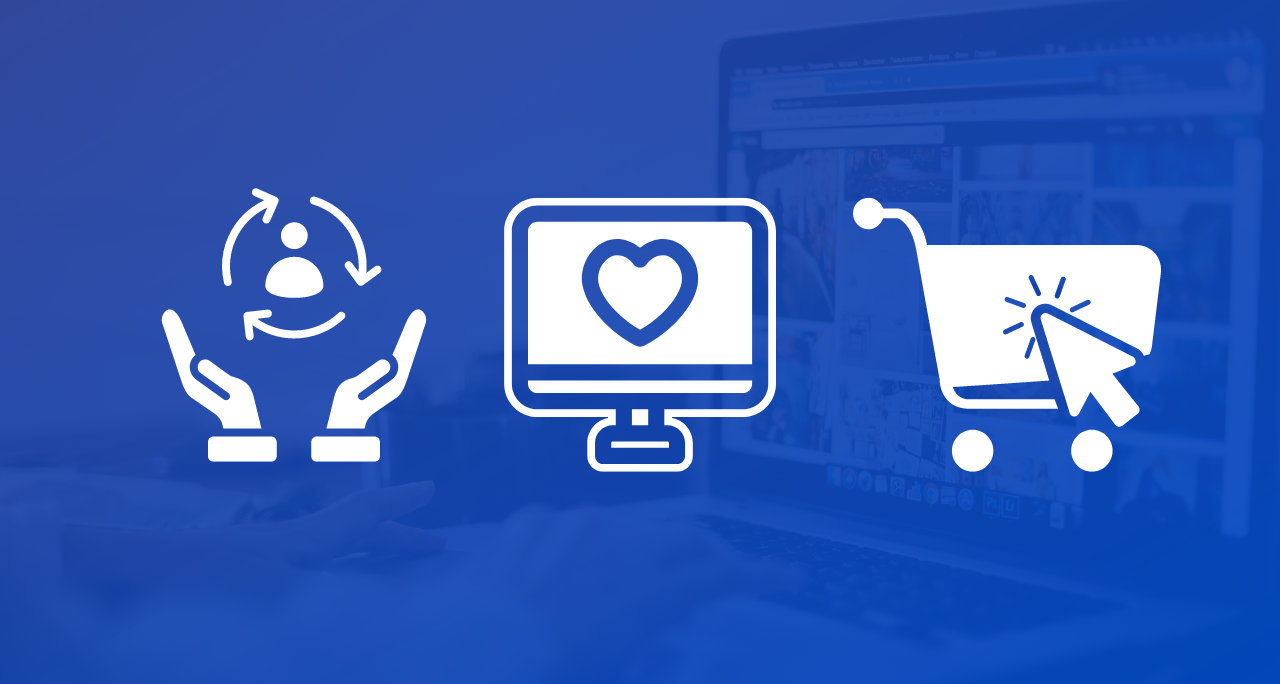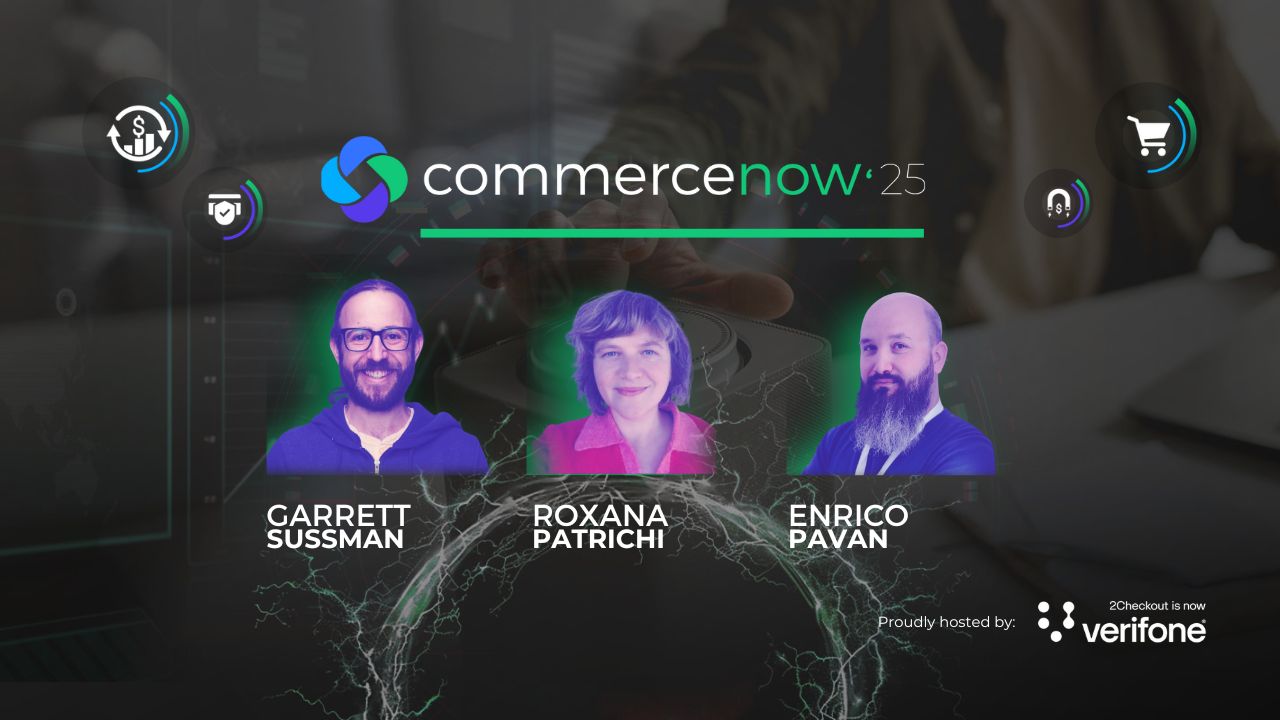These days, eCommerce shoppers don’t want to feel like nameless, replaceable site visitors. They want to feel personalized, unique connections with their favorite brands. Knowing how to provide the personal touch to each of your eCommerce site visitors is key to dominating your niche and target market.
Not sure where to start? Let’s take a look at why personalization in eCommerce is so important and how you can implement it on your eCommerce site in no time.
Understanding the Power of Personalization
Personalization’s strength lies in its ability to craft customized, pertinent, and enjoyable experiences that deeply connect with individuals, nurturing more robust customer bonds and propelling business triumph.
Don’t discount the benefits of personalization in eCommerce brands like yours. According to certain studies, 66% of customers want modern businesses to understand specific requirements, expectations, and needs
For instance, consider an online clothing retailer that uses a customer’s past purchases and browsing history to suggest outfits that match their style. This tailored approach not only enhances the shopping experience but also boosts the likelihood of repeat purchases and word-of-mouth recommendations.
In the long term, personalization can also lead to greater profitability. Consumers have either chosen, recommended, or paid for a business that provides at least one personalized experience or service. Bottom line: your business can’t afford to ignore personalization in the modern, competitive market.
The Evolution of eCommerce Personalization in 2023
eCommerce personalization is more important than ever, and it has recently evolved thanks to the integration of AI software tools and machine learning technologies. Many brands now use AI and machine learning eCommerce personalization tools to:
- Analyze great amounts of data about target audience members. It’s not just useful for personalization since it can also improve your long-term marketing everywhere.
- Provide automatic personalized assistance, such as referring to customers’ names during chatbot interactions. AI eCommerce personalization tools are adept at this.
- Determine which forms of personalization are most effective and profitable. If you use personalization well enough, you’ll eventually be able to predict customer profits and build your business accordingly.
At the same time, remember that it’s vital to ensure top-tier data privacy and security while providing a personalized eCommerce experience to your customers.
Successful Implementation of eCommerce Personalization
Many brands have successfully implemented eCommerce personalization to excellent effect. If you’re stumped on how to leverage personalization for your eCommerce brand, check out these real-life examples.
Personalize Website Behavior Based on Used Behavior
This approach involves using data and insights gathered from a user’s past interactions and behaviors on the website to create a more customized and relevant experience for them.
The news website Feedly used trackers and other software to personalize website behavior based on the activities of its users. For example, a user might browse several articles or pages, and Feedly might then recommend several similar accounts, writers, and news pages to follow for enhanced customer satisfaction.
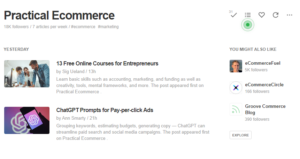
Show Returning Customers Continuous Shopping
The “continuous watching” feature found on Netflix is incredibly powerful for engagement. That same principle can be applied to the eCommerce sector.
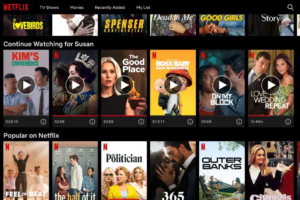
Retailers targeting a lot of growth can implement a continuous shopping section of their website, allowing visitors to immediately jump right back into what they were browsing previously. It’s as simple as using software that can remember a visitor’s selected items and preferences from previous sessions.
Create Personalized Lists
Manifesting as product suggestions, reading compilations, playlists, and beyond, a personalized list will touch the heart of many of your customers.
The popular craft, jewelry, and trinket store platform Etsy offers personalized recommendations and lists for its users. This even extends to personalizing user product landing pages.
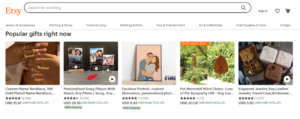
This is a great way to make your customers feel like you pay attention to them and their preferences and drive greater site engagement and higher conversion rates. Overall, this is one of the most common and effective eCommerce personalization trends.
Social Retargeting
Social retargeting is the art of bringing visitors back to your eCommerce site through social media. However, the best way to do this is through proper timing. Cassetify does this perfectly, using retargeting ads to remind customers that they were previously browsing their products. This is possible with AI-powered tools, presenting ads and marketing materials at just the right time to drive conversion.
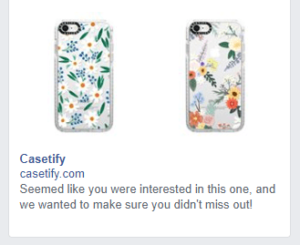
Complementary Product or “Complete Collection” Recommendations
The clothing brand Falconeri recommends complementary products or products in a collection that a customer already started to inspire further purchases and long-term loyalty.
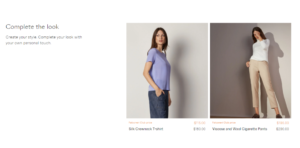
This is a perfect type of eCommerce personalization for customers who oftentimes purchase multiple things in the same session. It’s also a naturally good fit with industries like clothing/apparel, fitness, gaming, and more.
Personalized Cart Abandonment Emails
Cart abandonment emails who click away from your eCommerce site back again and again, particularly if you personalize them. Add the customer’s name and their account information to convince them to give your products another look.
Asos is a perfect example of a brand that does justice, sending personally tailored emails that trigger automatically whenever a user puts a product in their shopping cart but doesn’t complete the purchase.
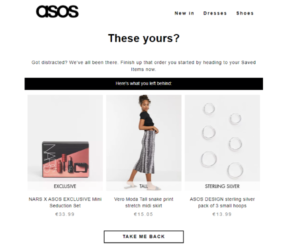
Special Offers for First-Time Visitors
There’s no such thing as a second first impression, so it may pay to take a page out of Revolution’s book. Revolution is a retailer for beauty products, provides all new customers with special deals, like 20% off your first order, if you sign up to the newsletter. Not only does this make a stellar first impression, but it may very well inspire a customer to put something in your brand’s if they were previously on the fence about converting.
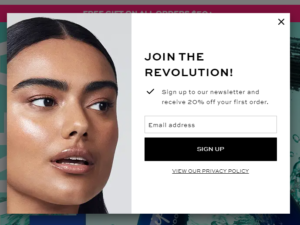
Personalized Exit Offers
Similarly, you can personalize exit offers, which pop up if a visitor clicks the back button or exits without purchasing anything. Think of this as a last-ditch attempt to convince a prospect to convert. Aerie does this very well by automatically detecting exit behavior (like a mouse cursor going to the top of the screen), then producing a special offer at the last second.
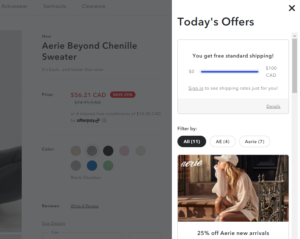
Special Deals to Inspire Returning Customers
What about customers who click away from your site and don’t seem to be returning? You can use personalization to entice a return visit to your eCommerce shop with special deal emails.
As an example, Sephora sends all Insider members who haven’t purchased a product in a while an exclusive 10% discount. This not only rewards loyalty program members but also helps to drive long-term and consistent conversion and engagement across its eCommerce site.
Milestone and Special Moment Celebrations with Personalized Offers
Milestones and special days like birthdays are excellent opportunities for eCommerce personalized marketing. Asos does this better than many other brands, offering personalized birthday emails for previous shoppers and program members.
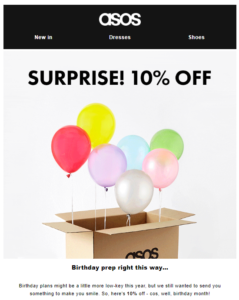
Dynamic Pricing
You can also leverage personalization with dynamic pricing. This unique pricing strategy uses AI personalization tools to analyze lots of data quickly, then determine the most attractive price for users. Uber, the rideshare company, does this in real-time every day, adjusting its fees for users based on things like traffic, popularity of the root, and user history.
Conversational Shopping
Conversational shopping allows eCommerce visitors to use chatbots, voice chat, AI assistants, and even support agents to navigate through an eCommerce store and get the products they need. This is most effective when using a comprehensive platform like Intercom, which makes chatbots help customers on a moment-to-moment basis.
The rooftop vehicle tent brand Cascadia Vehicle Tents saw a conversion rate increase of 27% with conversational shopping via text-based messages.

Personalized Support
Don’t forget to offer personalized support, such as creating personalized profiles for customer service agents, sending users personalized emails, and much more. Grammarly, for example, sends users a customized and personalized email every week to give them valuable data about their usage of the app and to track their progress and improvements toward their goals.
Conclusion
The landscape of eCommerce in 2023 demands a personalized approach. Shoppers seek meaningful connections beyond transactions. By infusing every interaction with a personalized touch, your eCommerce brand can forge deep connections, inspire customer loyalty, and thrive in the competitive market.
Use the examples and strategies mentioned above to master personalization, essential to thrive in your niche and foster loyalty, boost your conversion rate and ensure your brand’s longevity for years to come.

